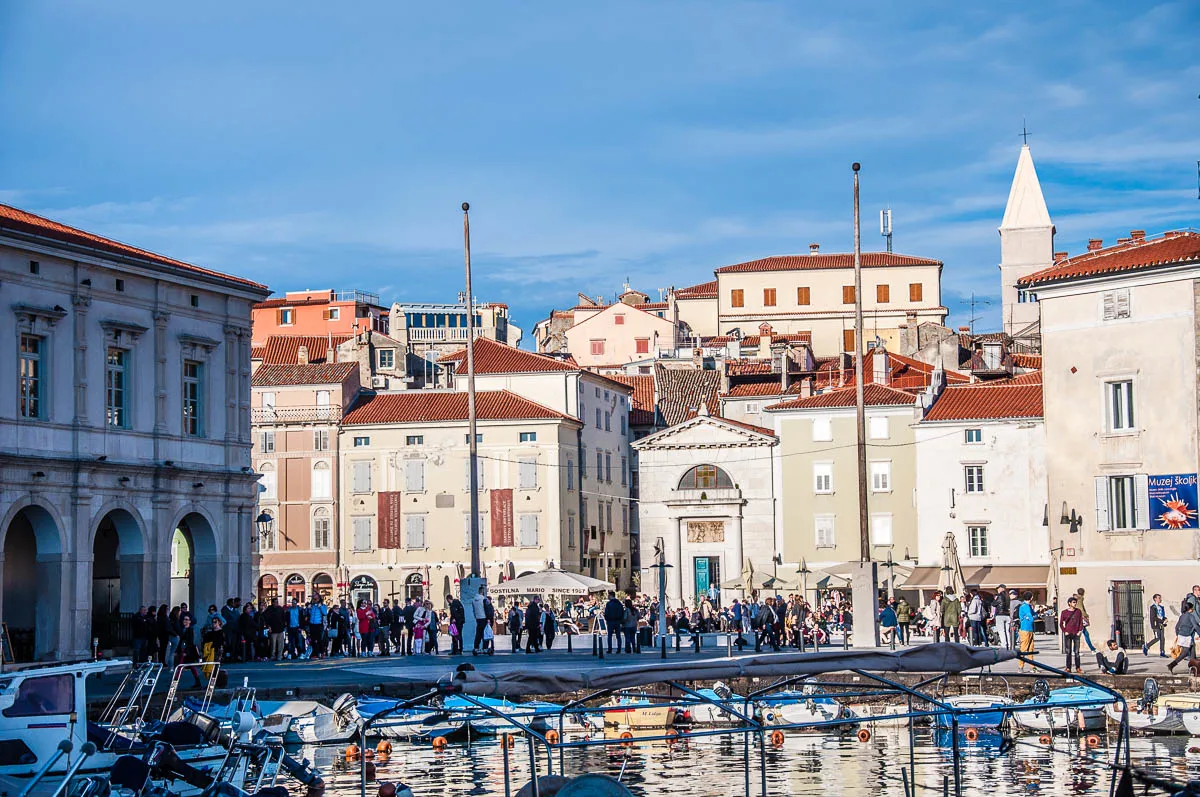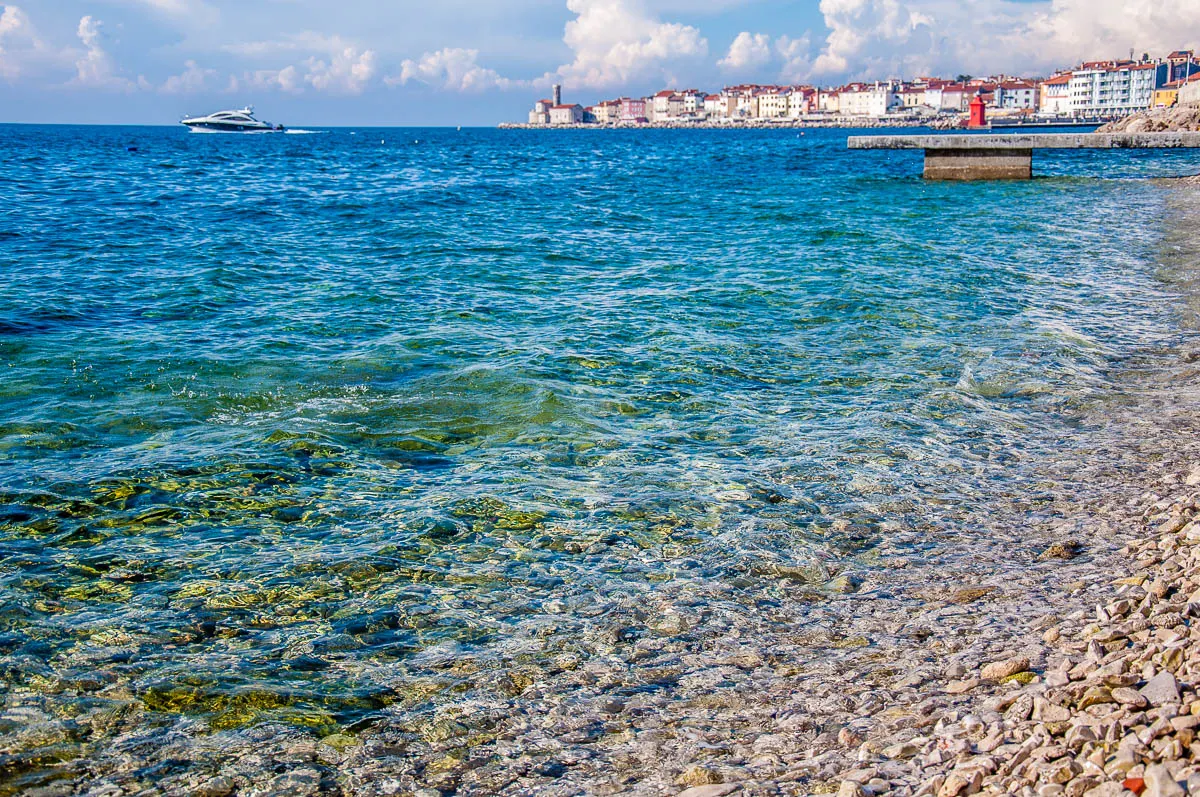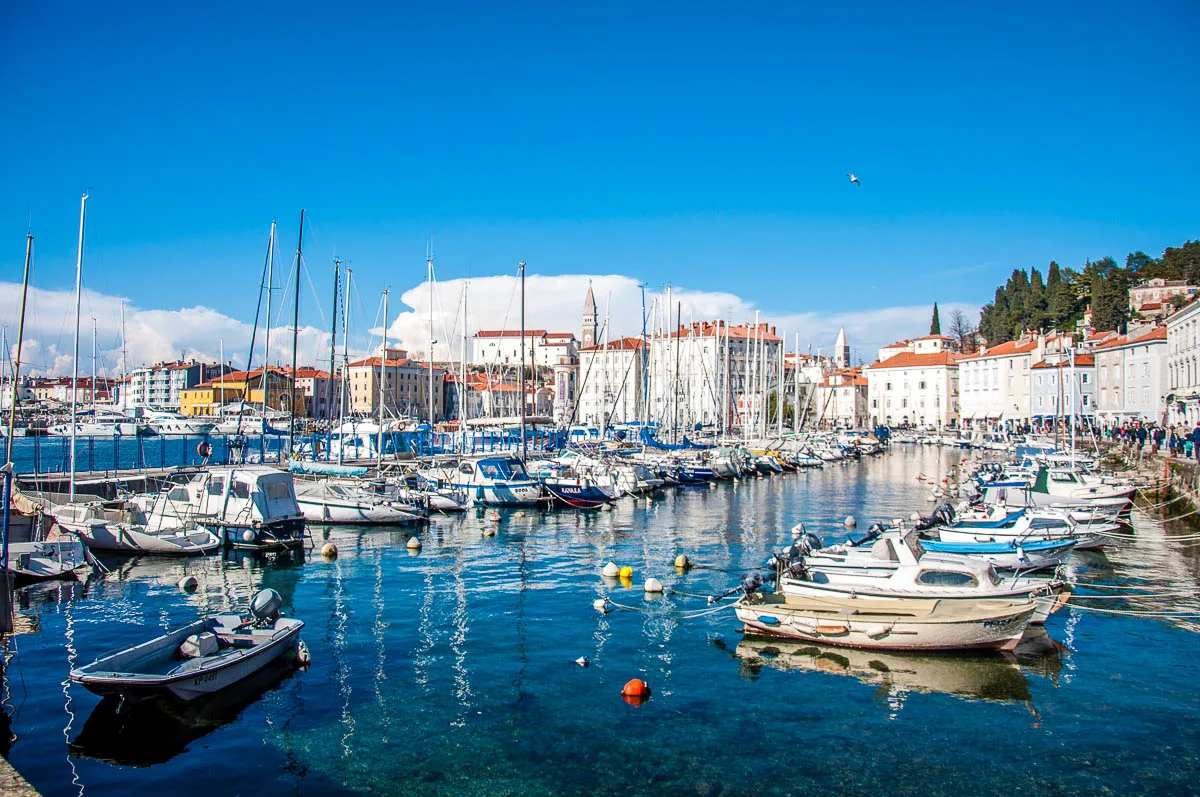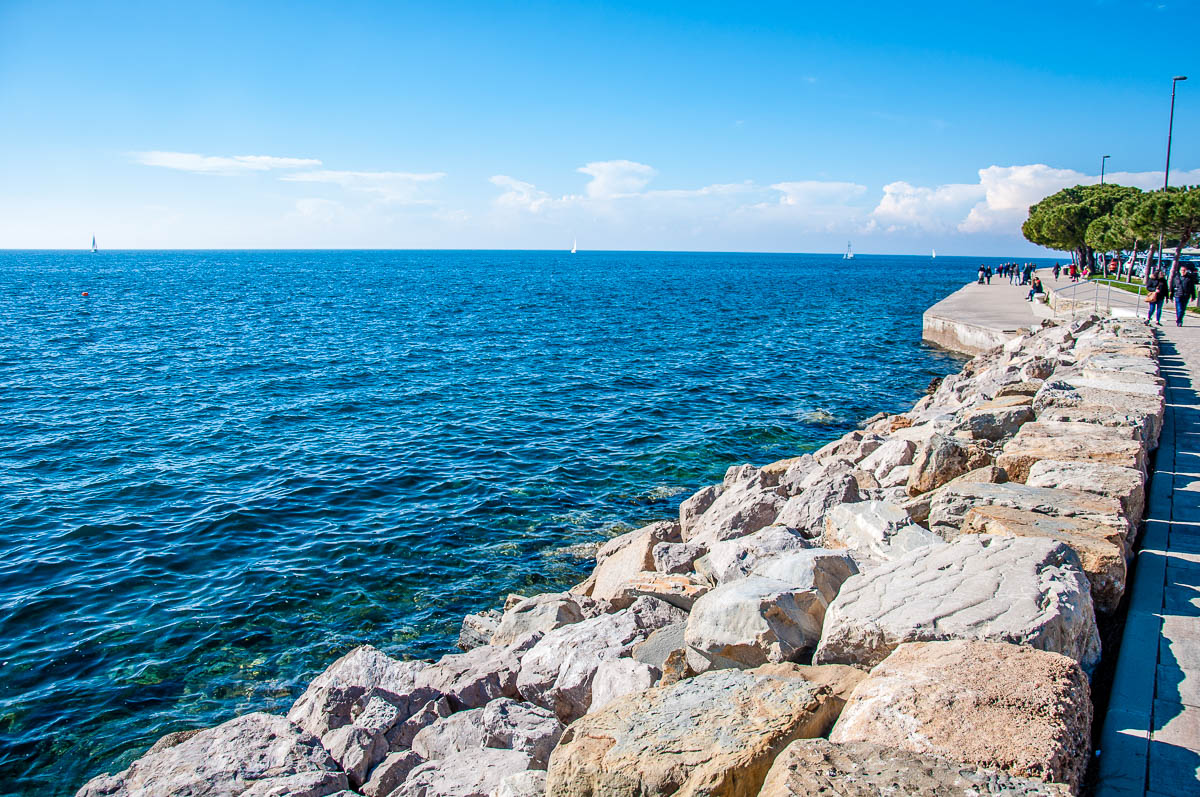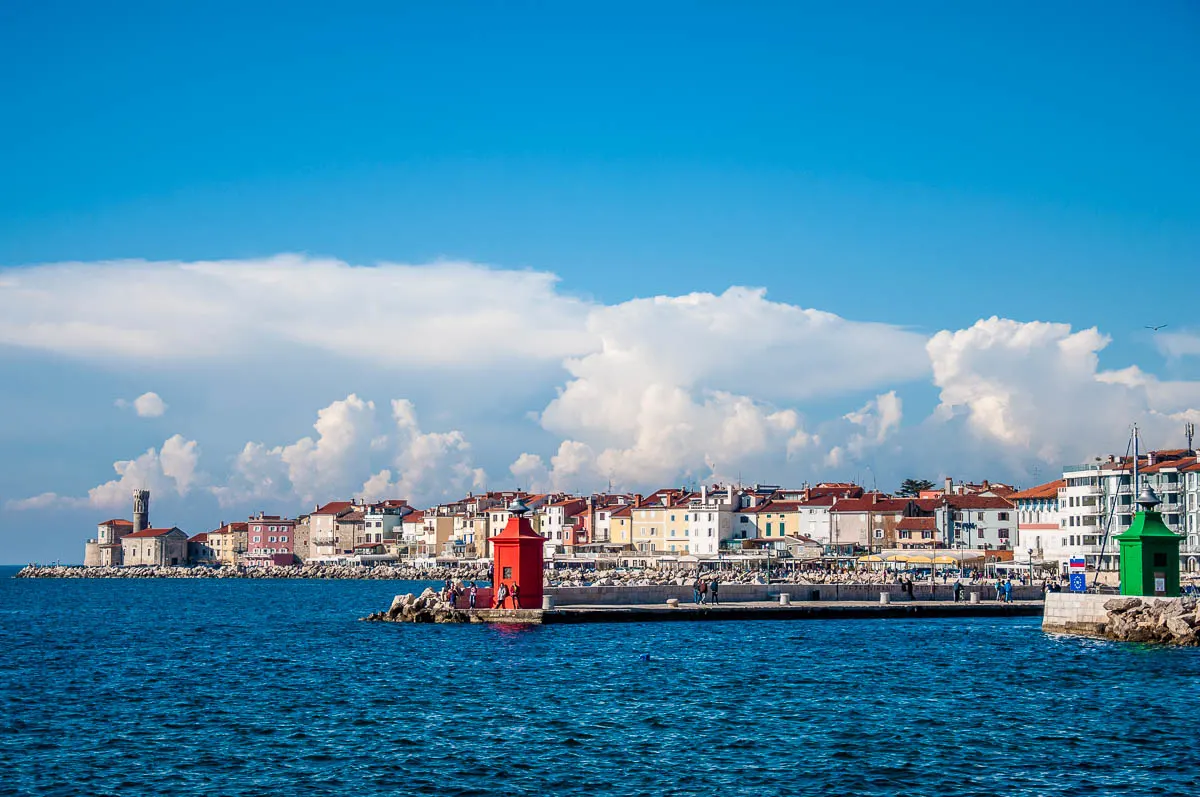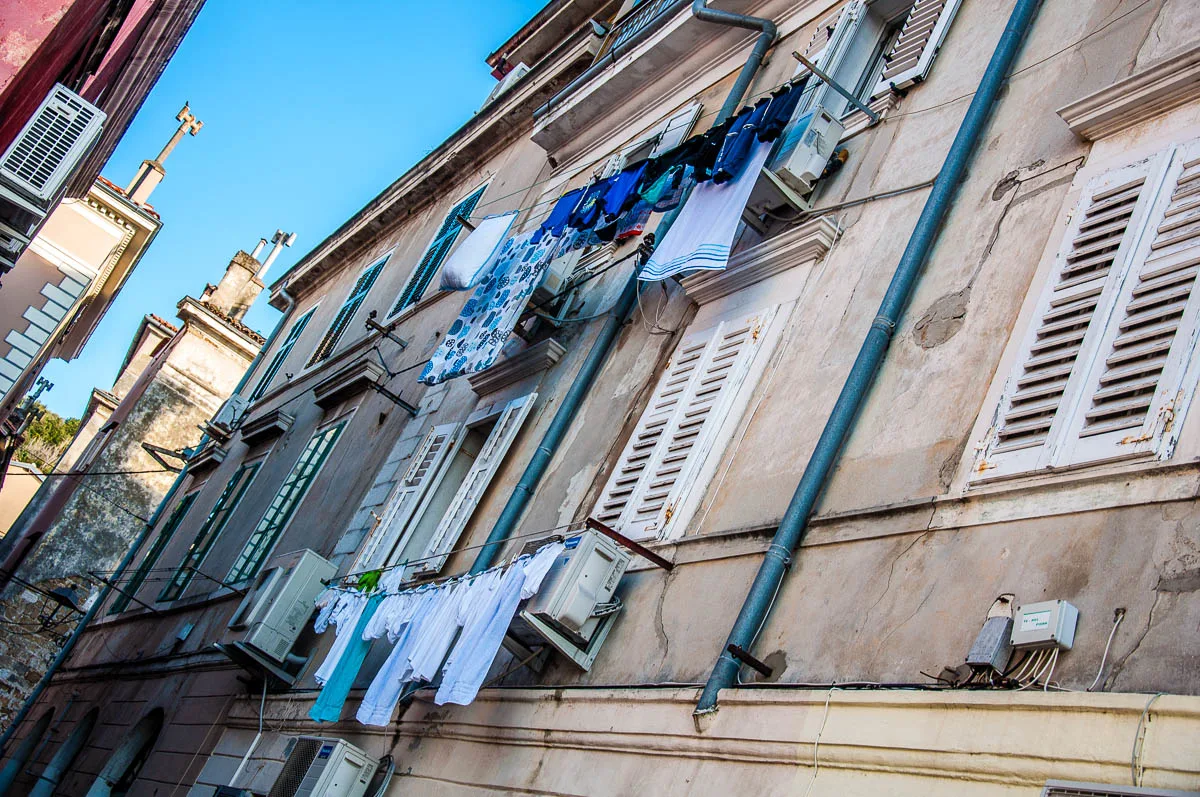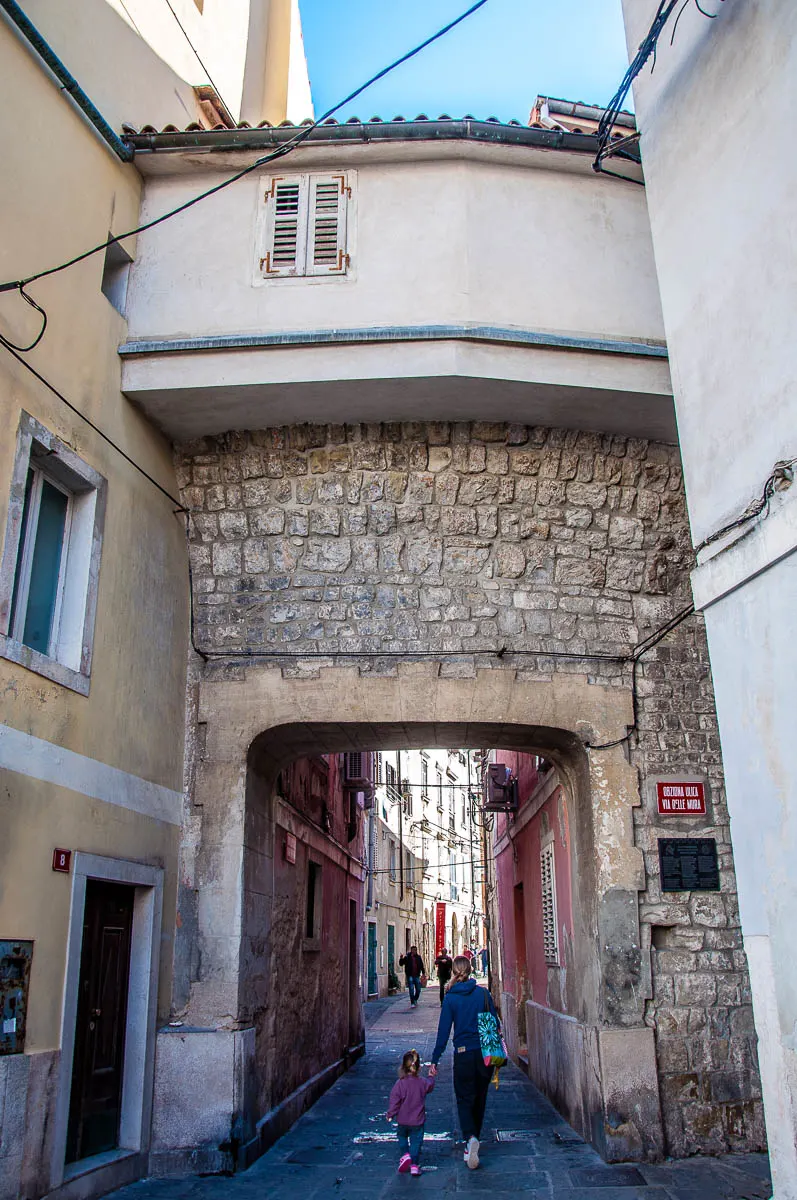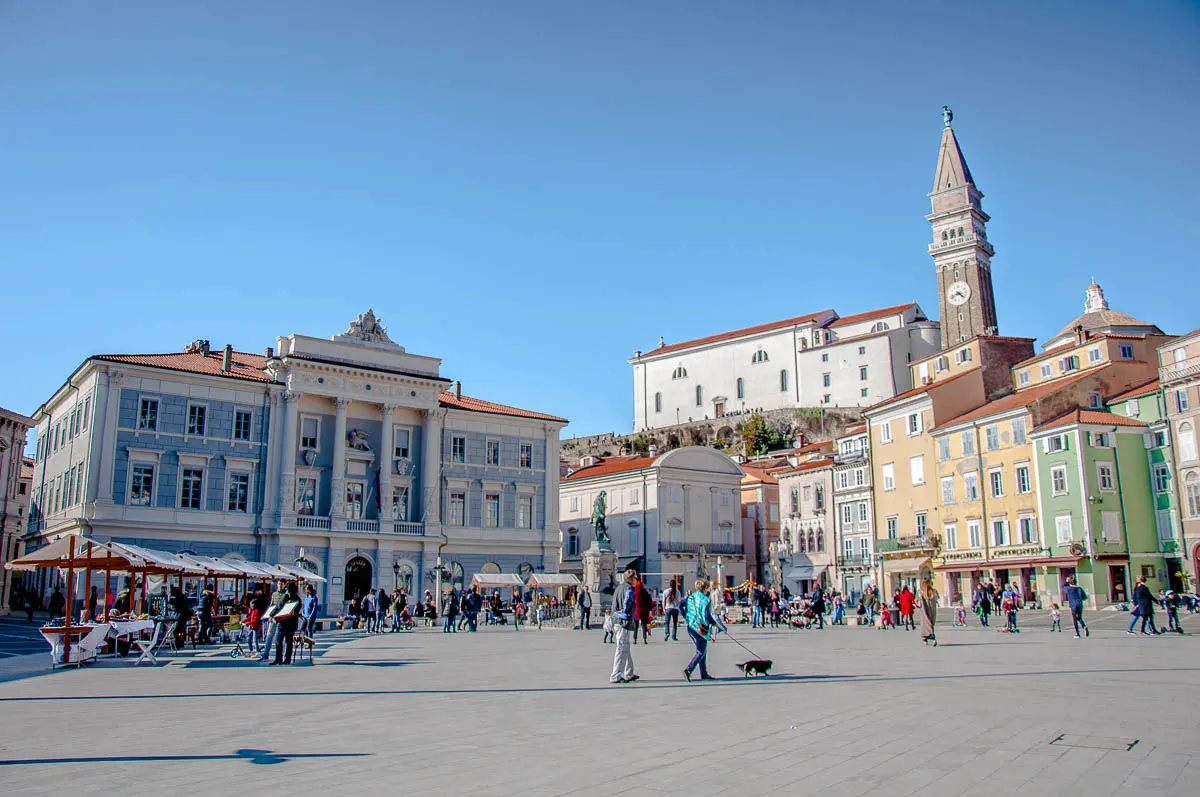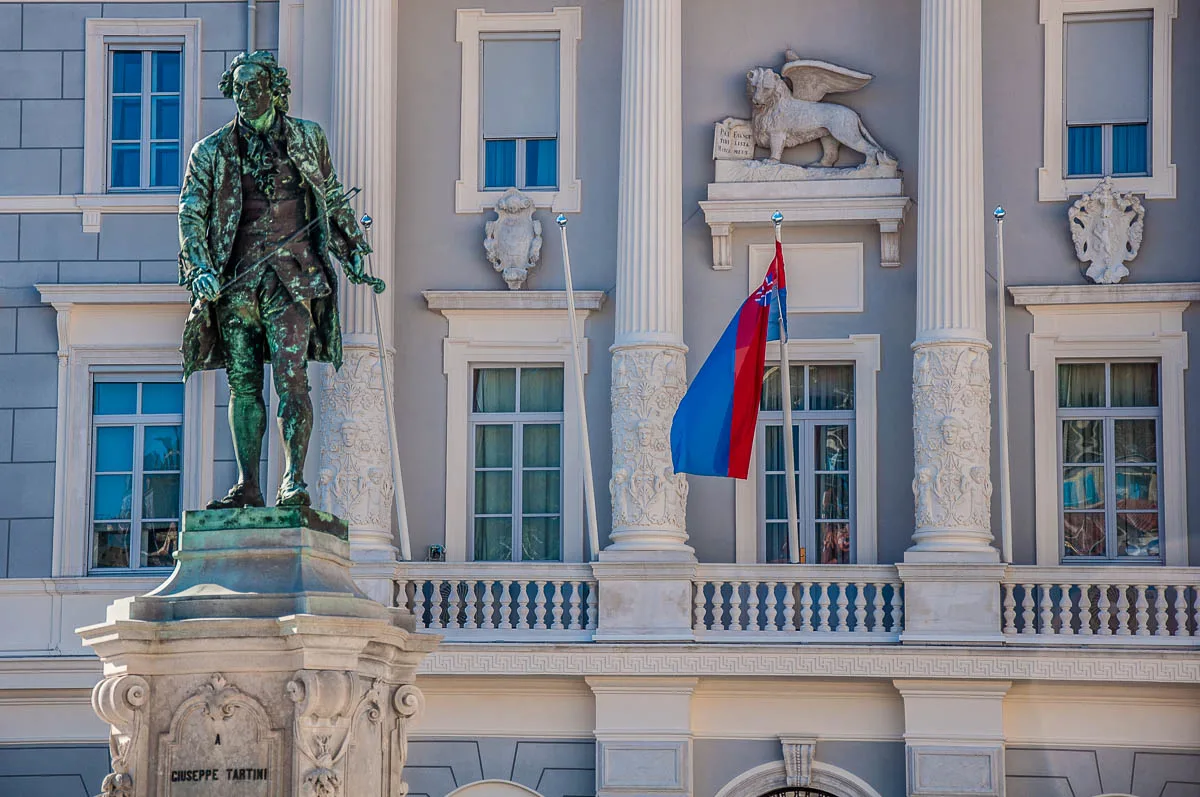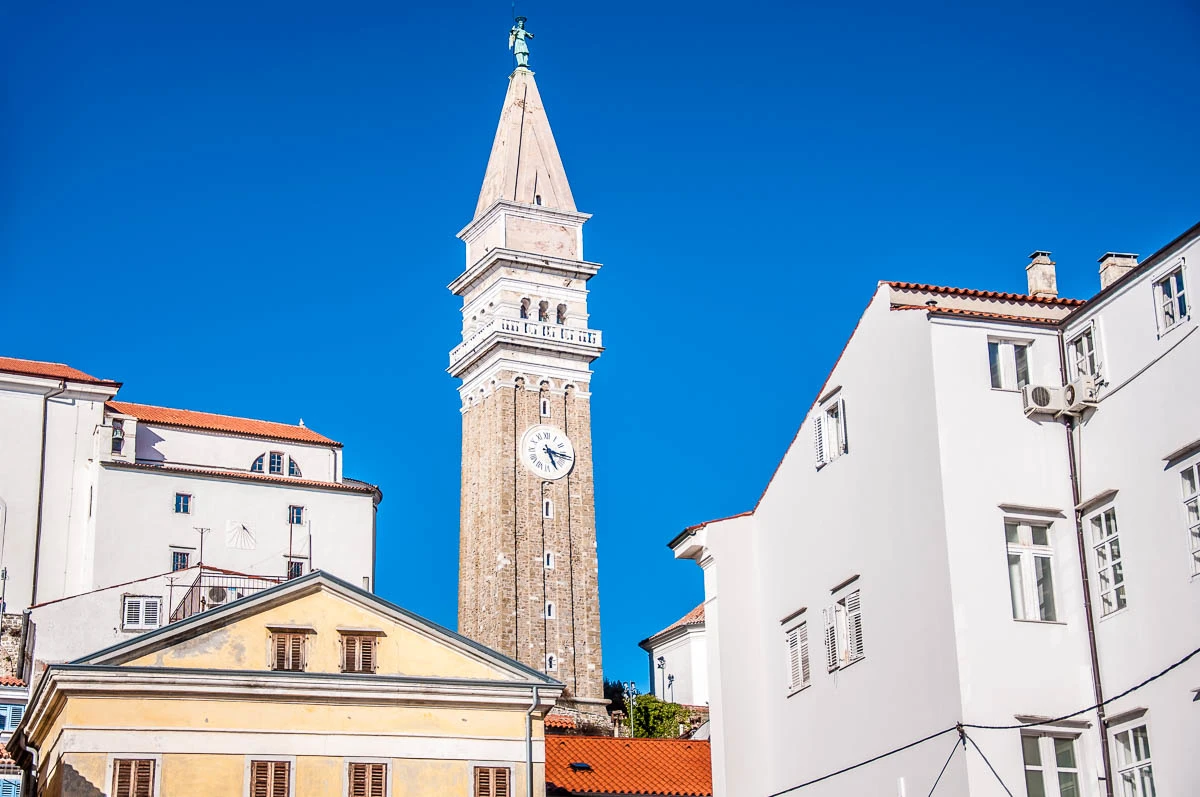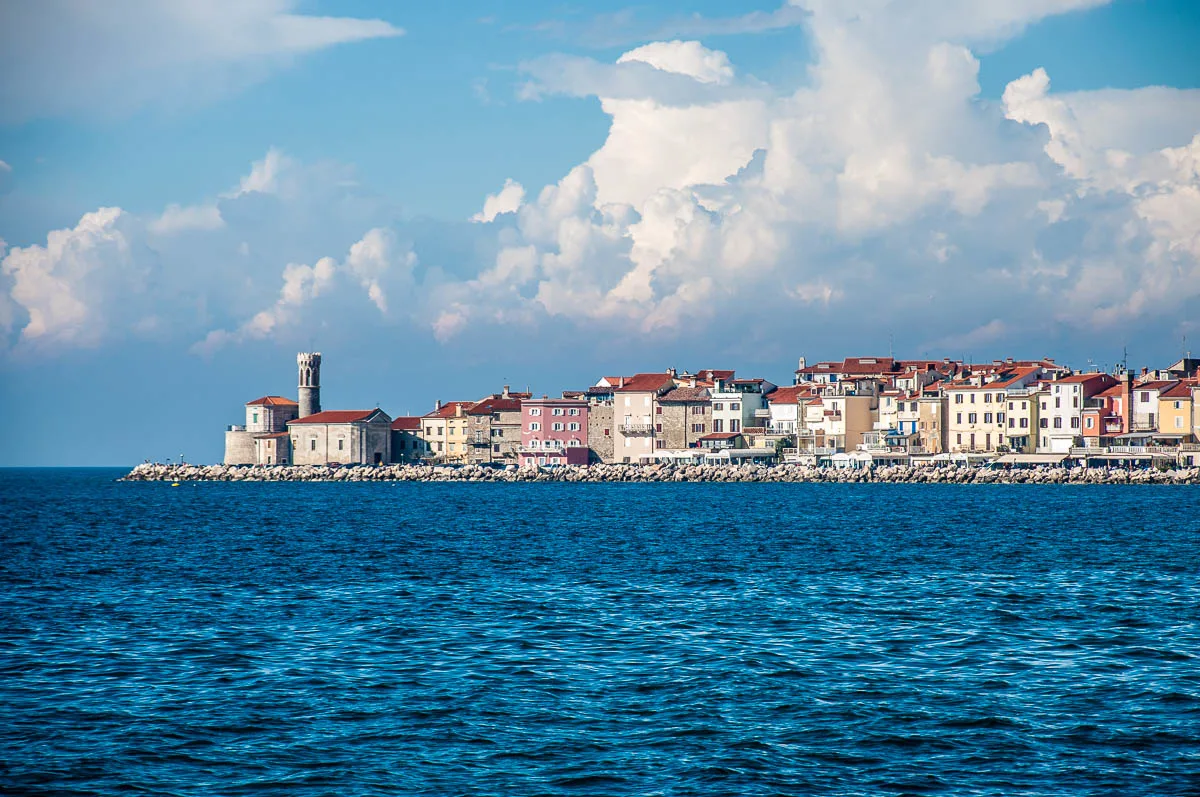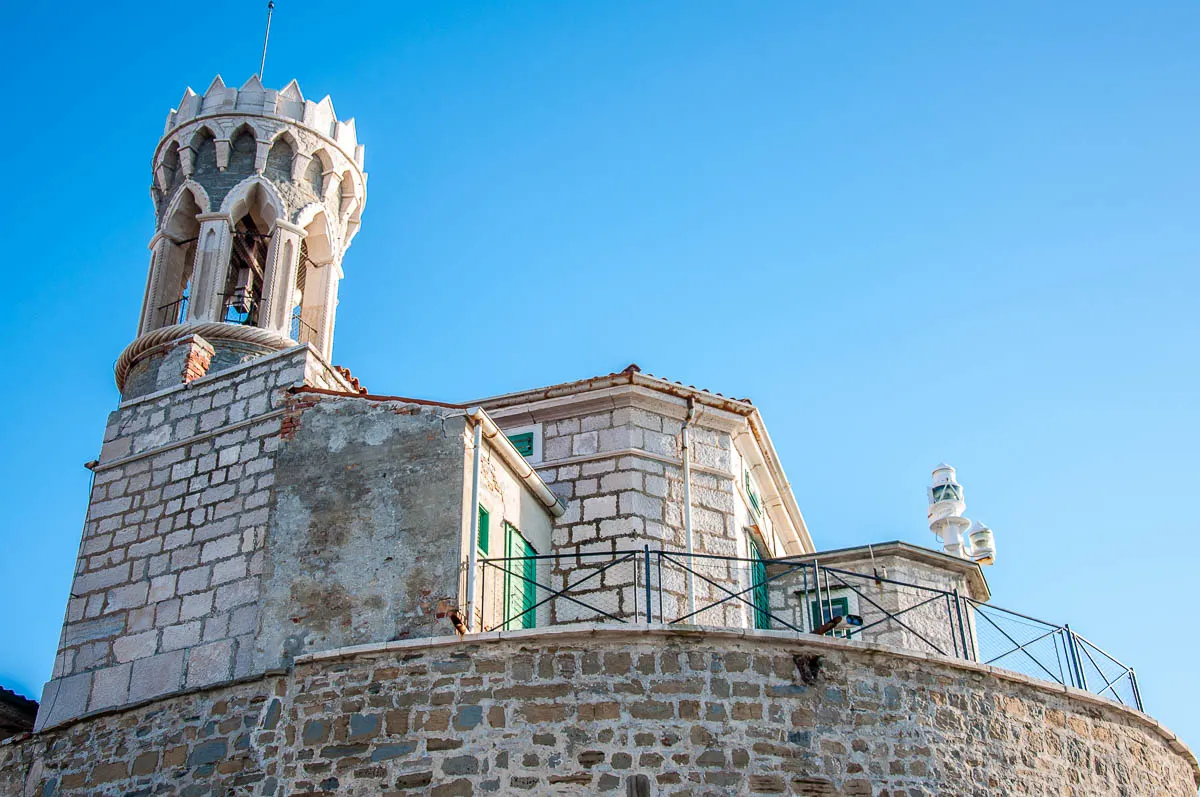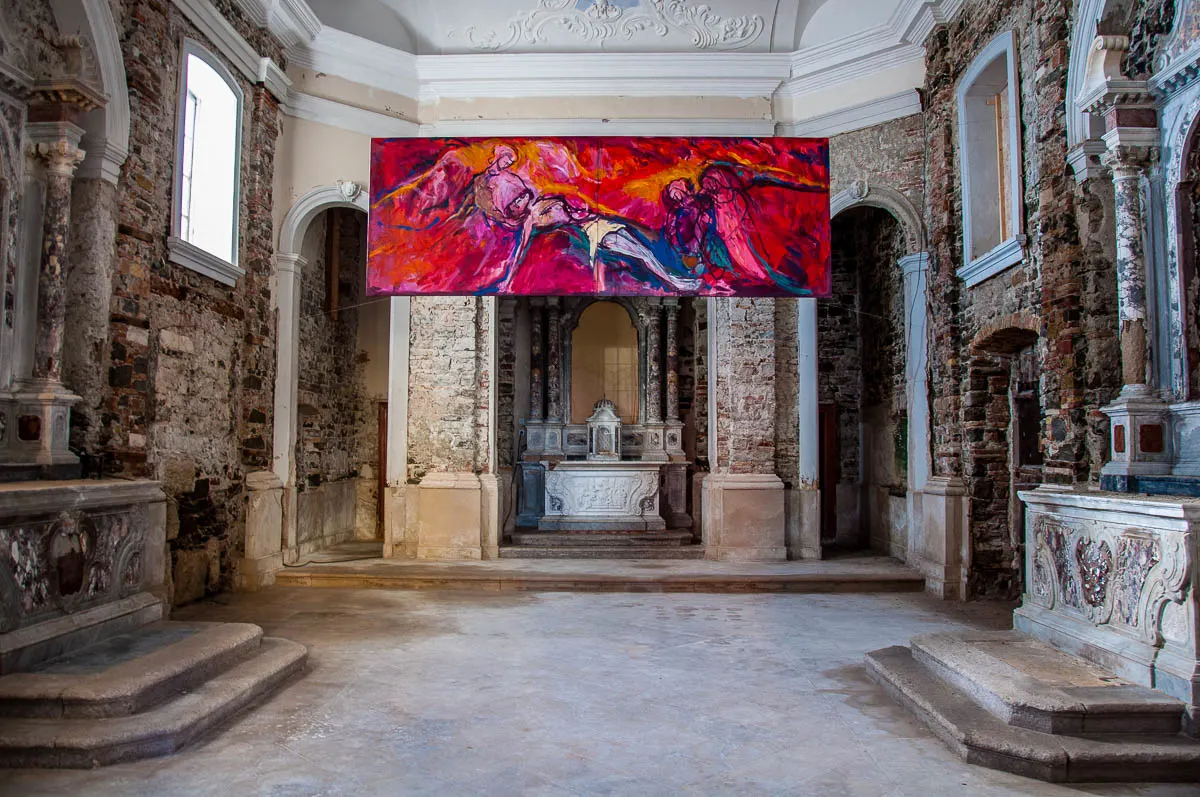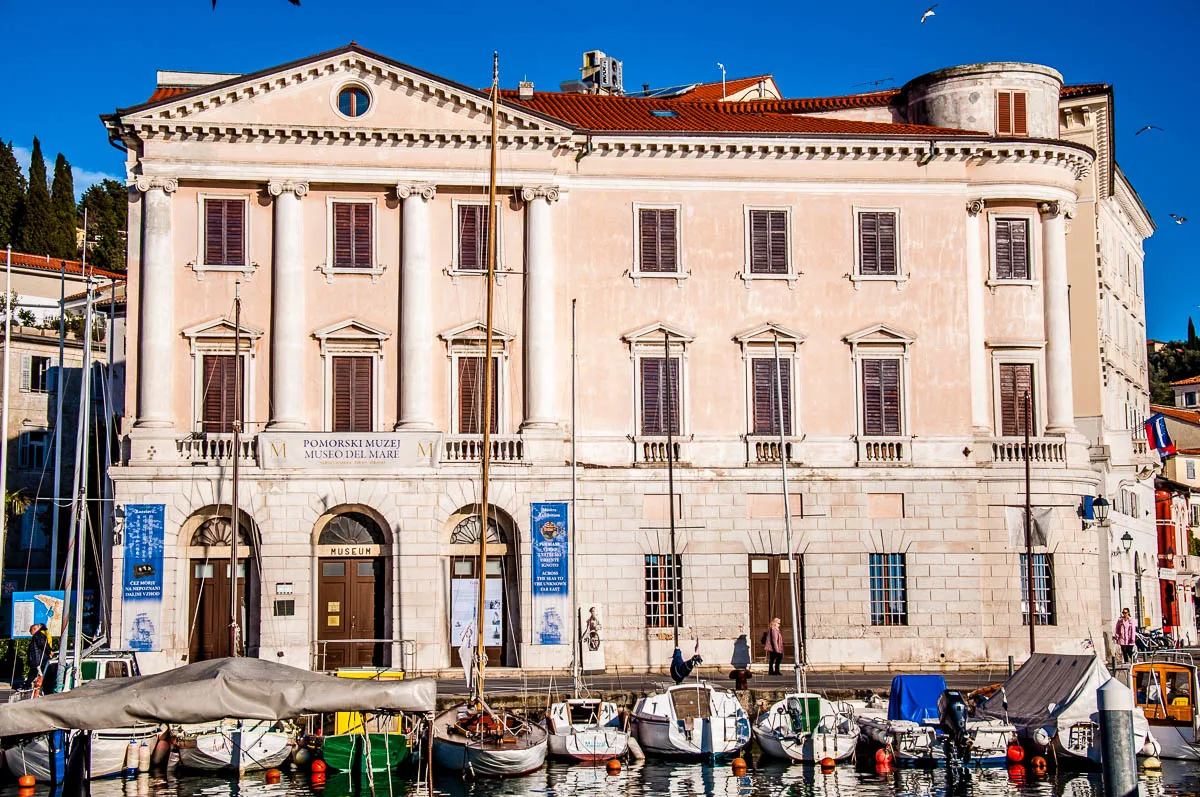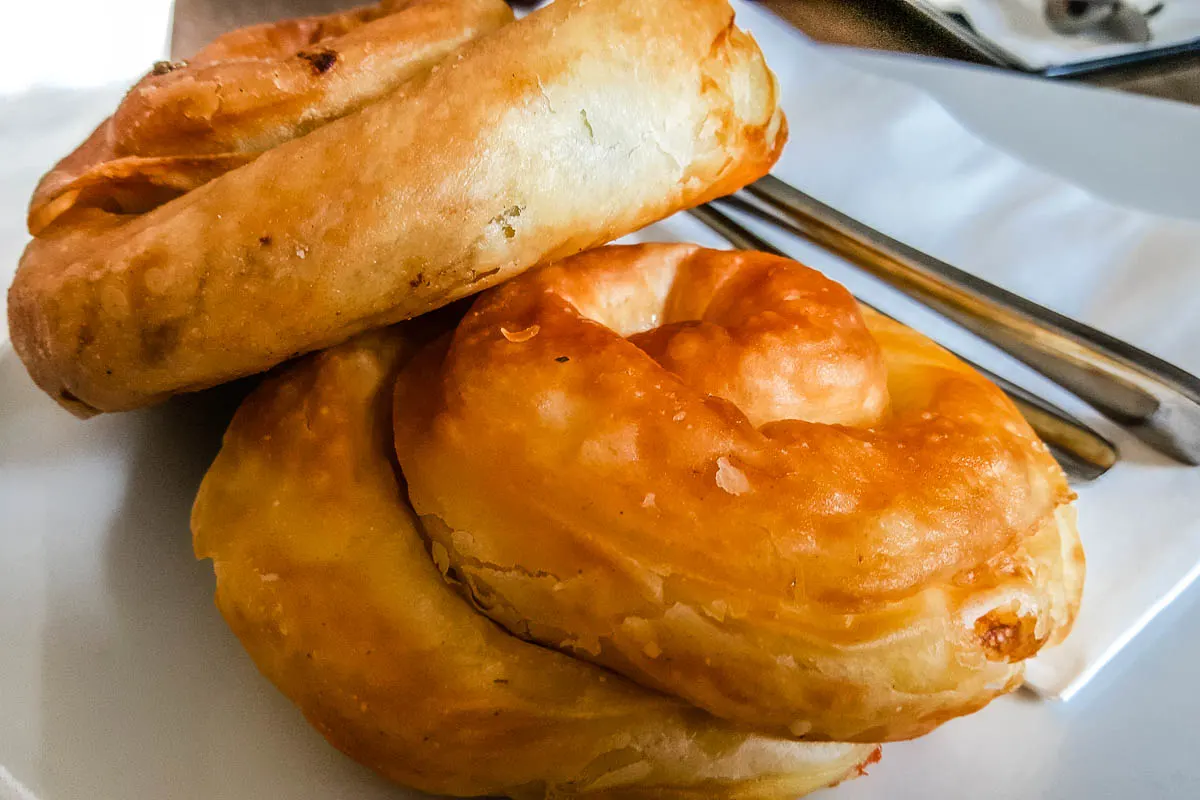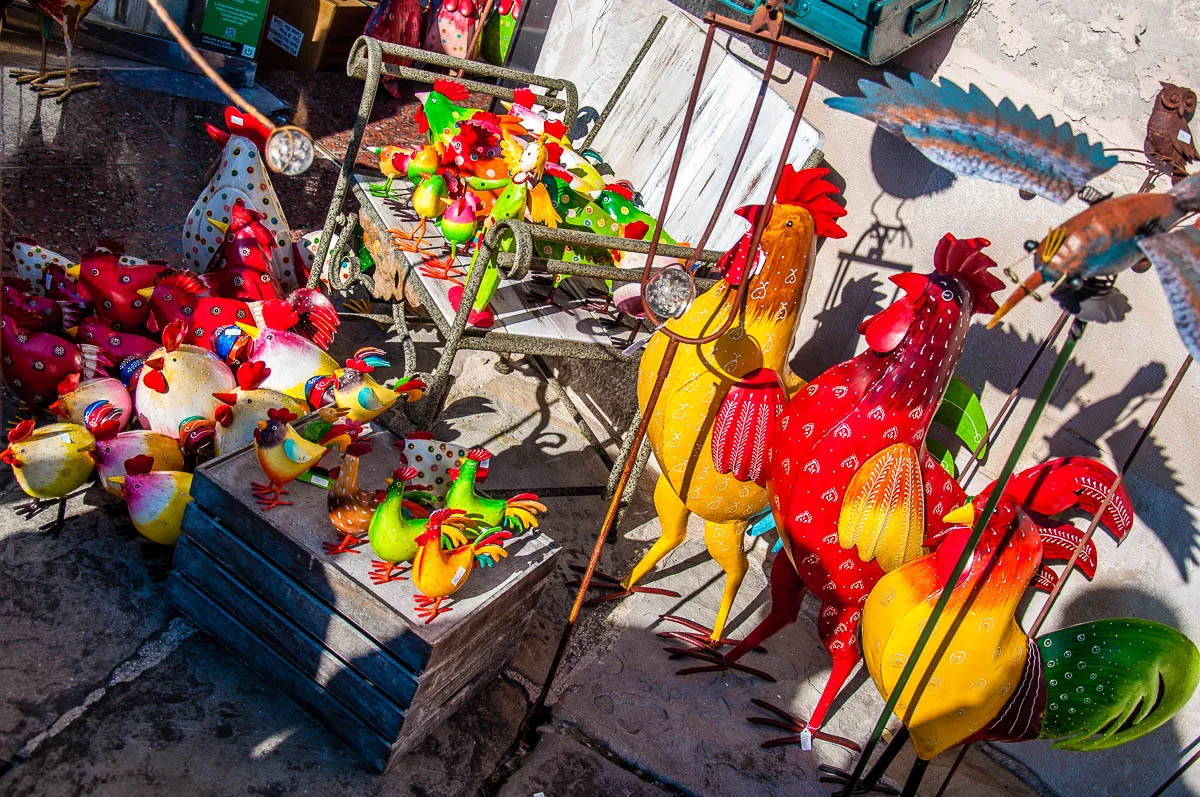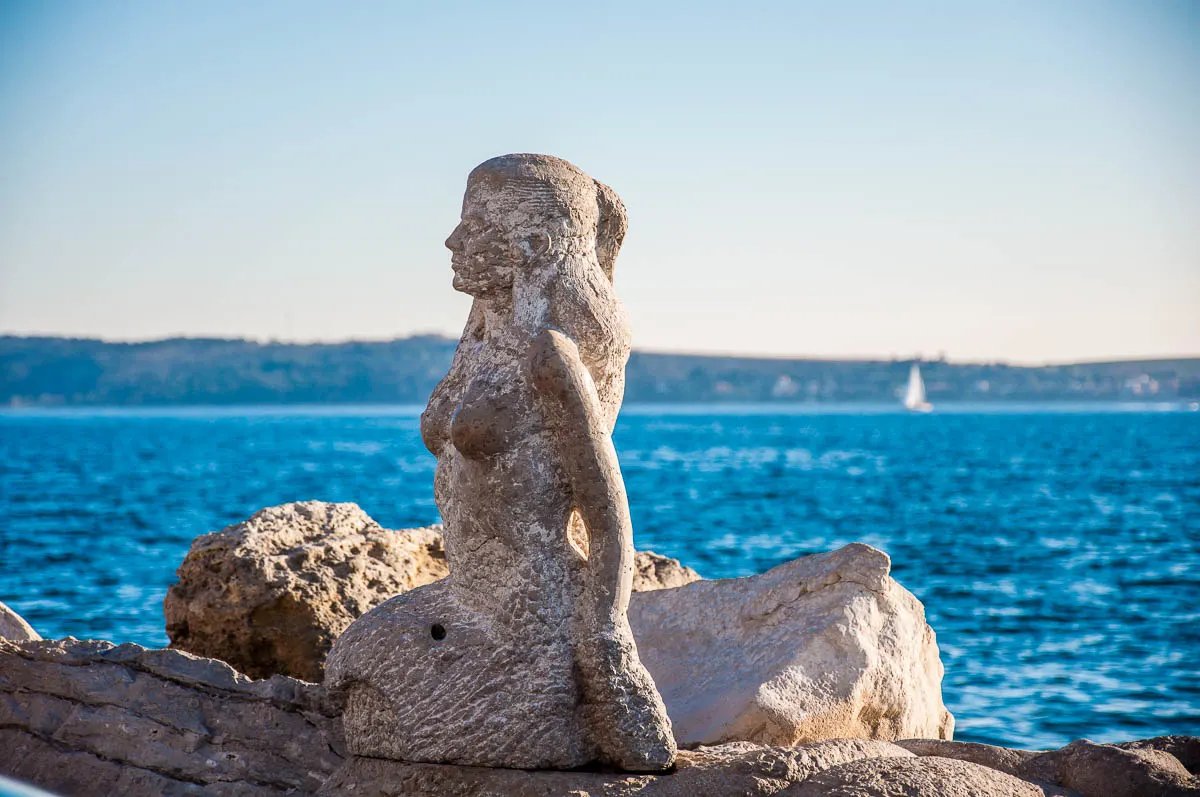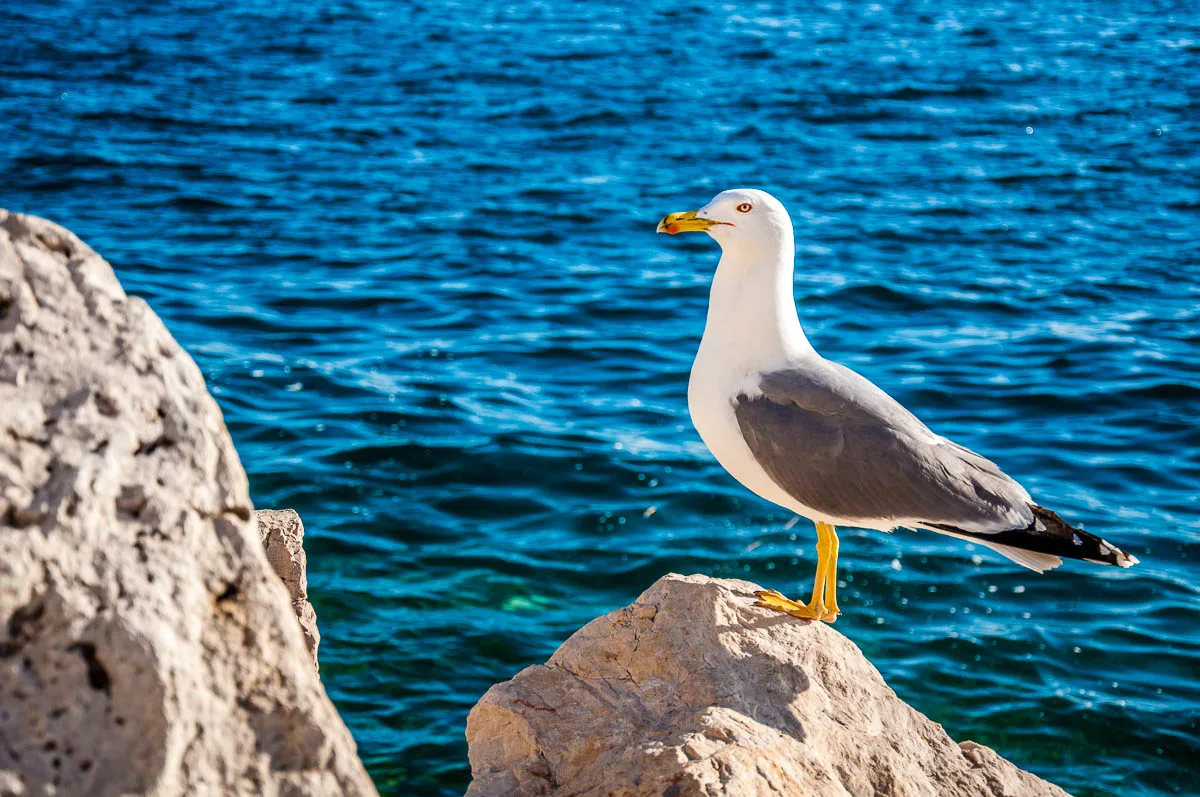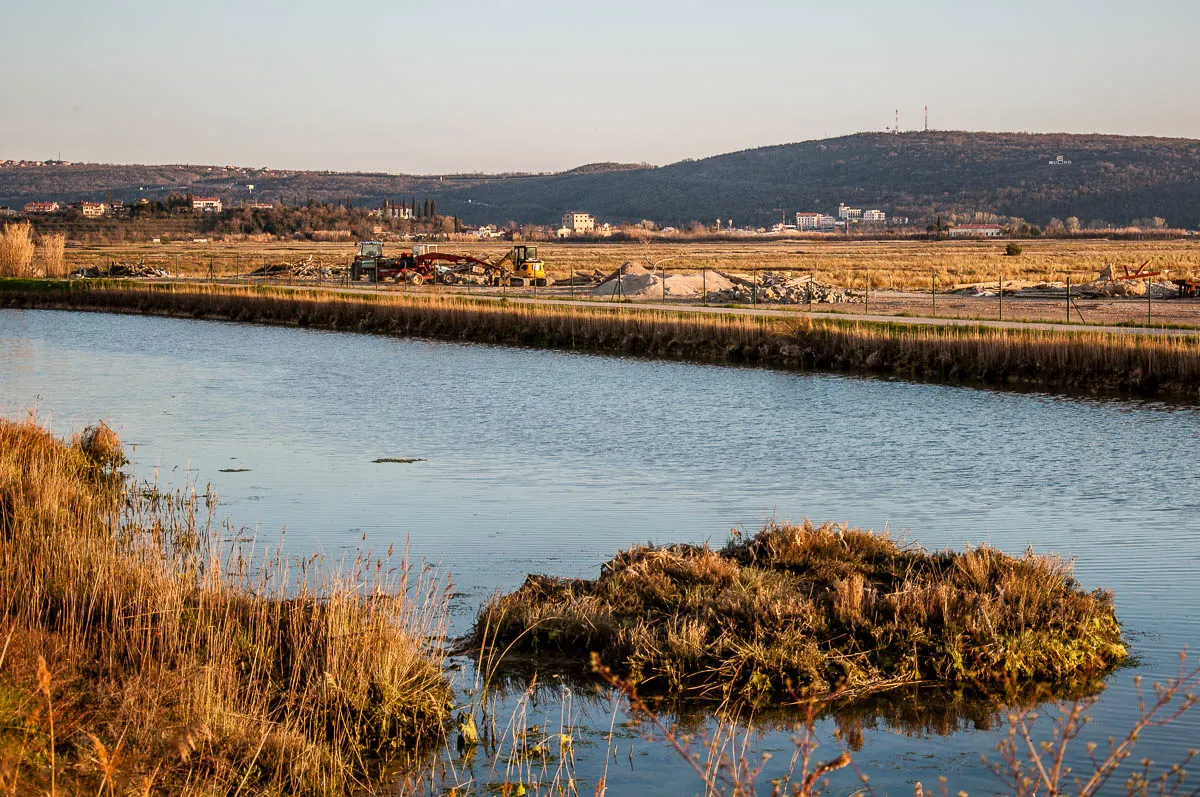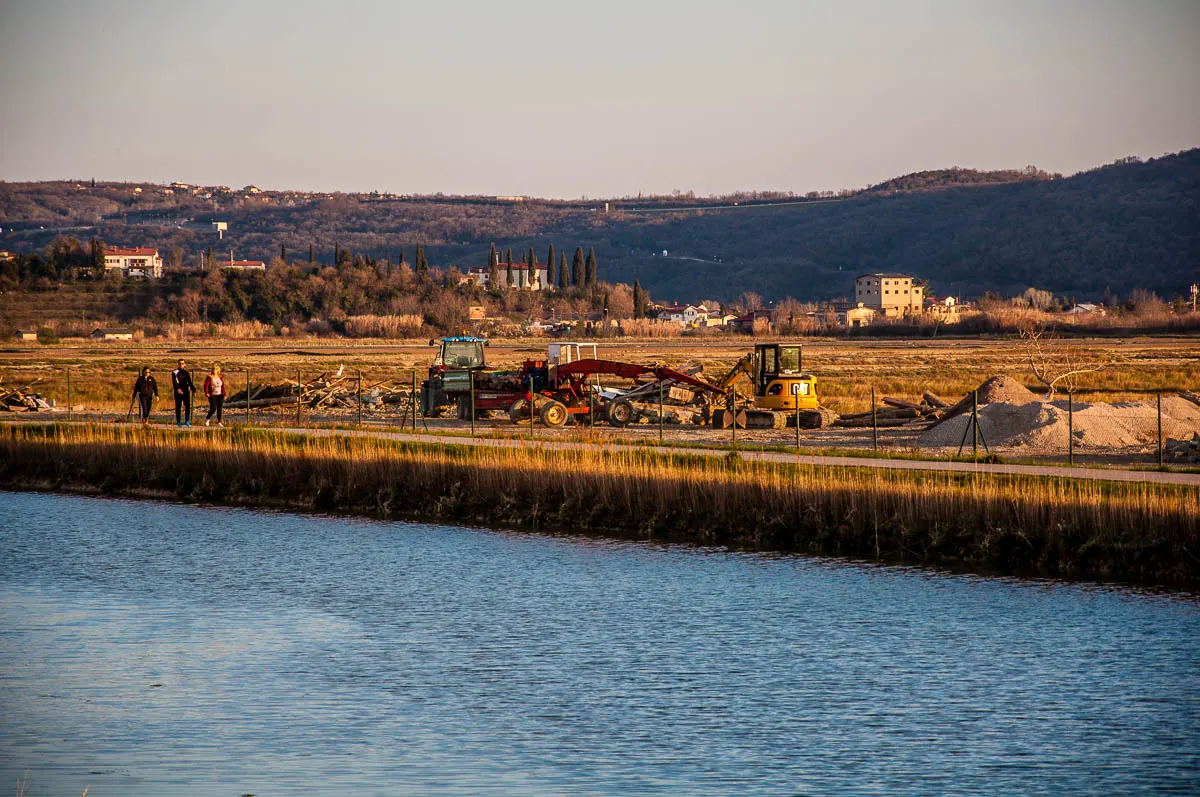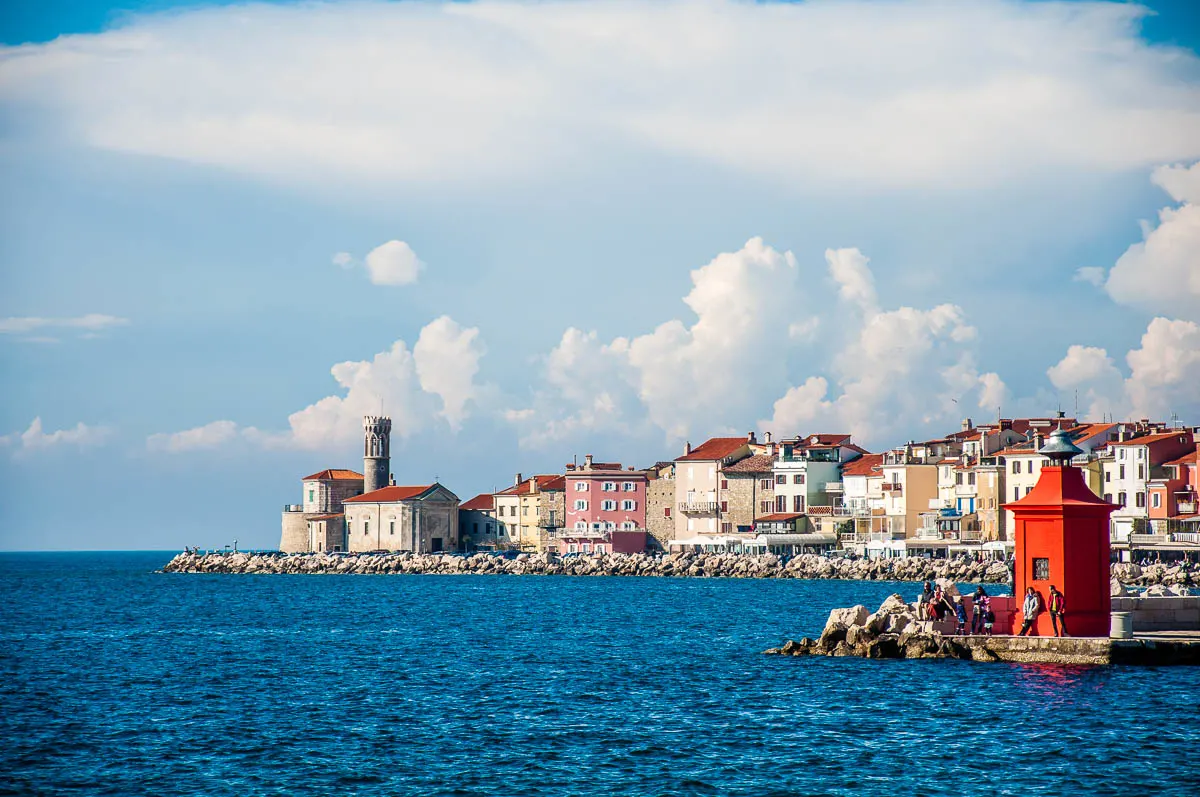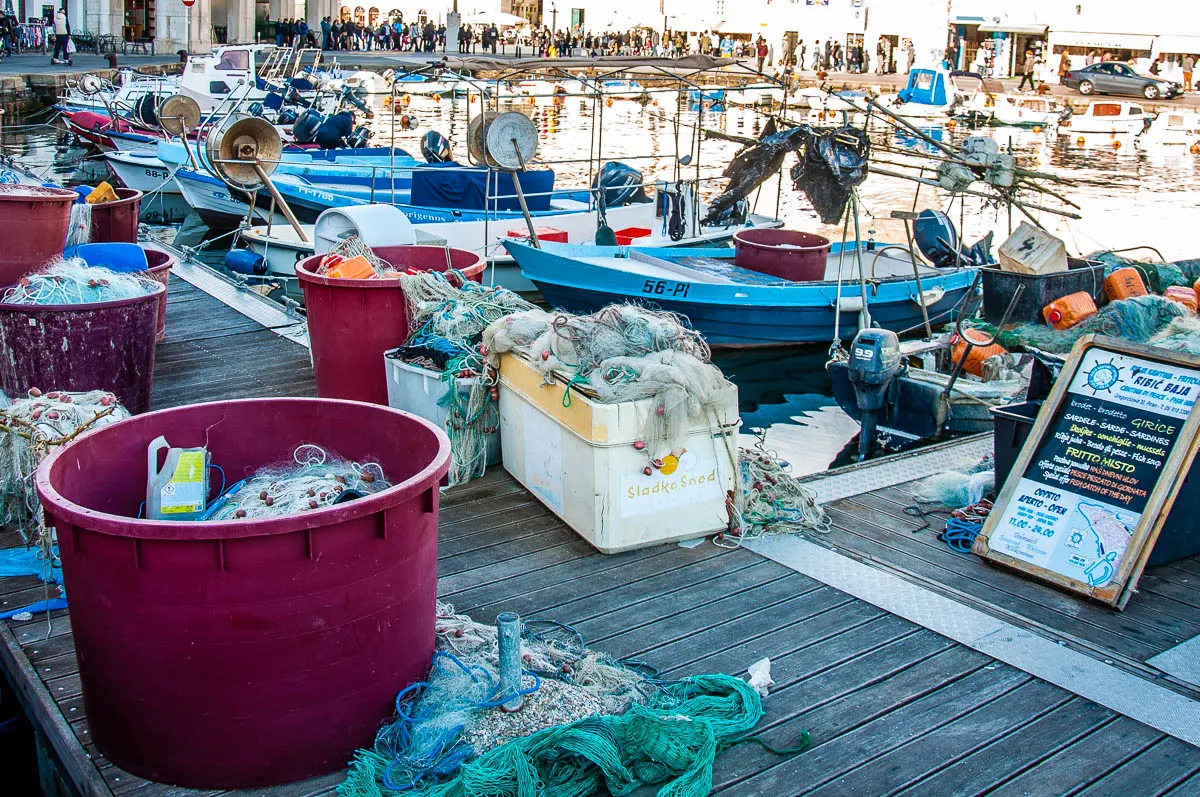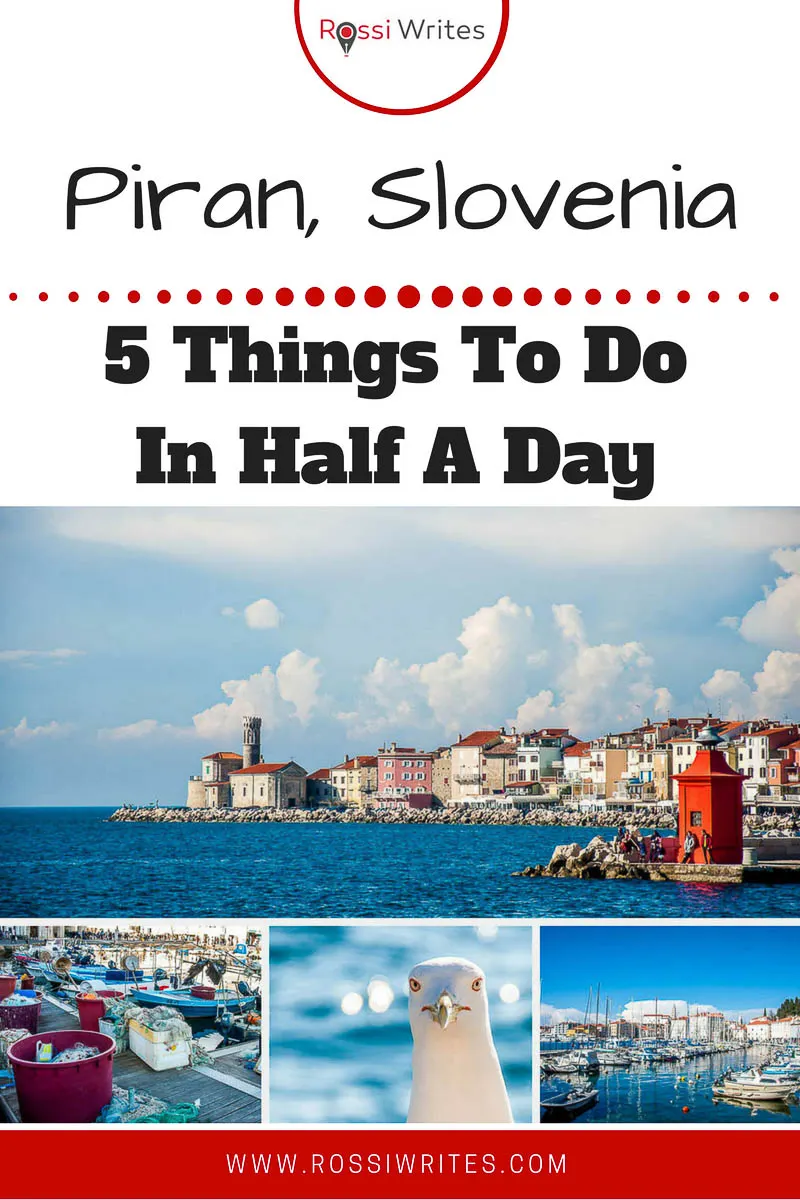Piran is a picturesque seaside town in Slovenia, rich in history, Venetian buildings and a fabulous Balkan snack called burek.
Now, Slovenia is that tiny European country where green mountains and blue lakes live in harmony with thermal springs and karst caves. Where rich traditions with a Slavic heritage have a bit of Austrian taste and a bit of Balkan flavour added to them. Where spacious houses sit prettily among lovingly tended-to gardens all over the countryside. And where whimsical wooden hayrack barns make you stop your car (as you drive on the smooth and empty roads for miles) and snap pictures to your heart’s content.
Add to this a nice little slice of the Adriatic seaside (tightly sandwiched between Triest on the Italian side and Croatian Istria on the other) and Slovenia becomes this quasi-perfect place, an almost idyll that everyone loves to return to time and time again.
Now, Piran is the pearl of the Slovenian seaside.
Perched on the end of a long peninsula, Piran’s Venetian buildings are embraced by a long promenade which is circled by the glinting Adriatic Sea.
When the sun shines bright, you get that amazing feeling of being free and everything being just right with the world. It’s quite overwhelming, really. In a very nice way.
It takes just under 40 minutes to reach Piran from Triest, Italy and just under an hour and a half to get there from Ljubljana, the Slovenian capital. So, it’s not surprising that Italian, German and Austrian tourists flock to Piran, Slovenia in their thousands. Apart from the beautiful setting, the historical architecture and the sparkling sea, there is also a large marina, an abundance of fresh seafood and ice-cream, as well as several museums and many nearby resorts.
Plus, all the prices are in euros and quite affordable.
So, if you have a chance to go there, don’t turn it down. Even if it is just for half a day. As, in fact, happened to me only a few weeks ago.
Over Easter this year, we travelled spontaneously to Rovinj in Croatia for a few days. As the road took us past Piran, we stopped there to spend a few hours sightseeing and relaxing.
We didn’t know exactly what to expect but Piran turned out to be a great stopover for us. As such, here are five personally tried-and-tested things you can do and enjoy there even if you have a very limited amount of time on your hands.
Give them all a try!
5 Things To Do In Piran, Slovenia If You Only Have Half A Day
1. Walk
With Piran’s Old Town being a restricted driving zone, you will most likely need to leave your car at Fornače. This is a huge multi-story parking lot just on top of the hill on the approach to Piran. Click this link for current information about parking fees.
From Fornače you can take a free shuttle bus into town or you can simply walk. We did the latter. A wide promenade connects the Fornače parking lot with Piran’s Old Town. At all hours of the day, people are out there in force enjoying a gentle stroll.
It is really lovely, so take your time. Especially, as this is where you can get the best views of Piran and the sea. The marina with dozens of white yachts, the red and the green lighthouses, the Venetian houses – everything is so incredibly picturesque.
The curve of the peninsula on which Piran is located ends with the promontory Punta Madonna. All the while you are walking along the promenade, your eyes will be fixated on the tiny church at the end of this promontory. It’s like it’s calling you forward, making you curious to reach it and learn its story.
Once you reach Piran’s Old Town, make sure that you spend some time exploring its cobbled streets on foot. With windows and facades adorned with freshly laundered clothes hanged out to dry, Piran will remind you a quite a lot of a town in Italy.
In fact, Piran was part of the Republic of Venice from the 13th to the 18th century, which would explain its rich Venetian heritage. From the end of the 19th century to the beginning of the 20th century the town was within the confines of the Austro-Hungarian Empire. And then, between the end of the First World War and the end of the Second World War, Piran was part of Italy.
The Memorandum of Understanding of London in 1954 gave Piran to Yugoslavia where it remained until the Socialist Federal Republic’s breakup in the early 1990’s. Since then, Piran is a Slovenian town with Italian as an official minority language. The town’s Italian name is Pirano and signs everywhere are both in Slovene and Italian.
Walking past Piran’s gleaming marina and through its cobbled medieval streets, you cannot help but notice some slight traces of its recent socialist past. A street called ‘Lenin’ is lined up with distinctly Venetian-looking buildings. Further down ‘Partisans’ Street’ is right next door to the town’s thick defensive walls.
It is this mix of several cultures and ideologies that make Piran so interesting to explore. Nothing is absolutely clear-cut. You see one thing but you need to dig deeper and peel back several layers of history to truly understand its character.
So, yes, make sure that you walk as much as you can in order to truly experience Piran. The town is small so in an hour or two, you will cover a lot of ground.
Finally, here is a little tip: A hat and a sunscreen are a must when the sun is out, as it quickly gets hot. Still, the narrow streets offer shade and a nice cooling breeze.
2. Sightsee
Piran, Slovenia is rather compact and small. Only about 18 thousand people live there, after all. Still, the town has much to offer in terms of sightseeing and places of interest.
In order to utilise your time as best as you can, make sure that you have a plan in mind as to what you want to see and do there. Especially if you only have half a day to spend in Piran, Slovenia:
To help you out, here is a handy list of the main points of interest:
- Tartini Square – this is Piran’s main square. It is lined up with fancy bars, eateries, and colourful houses. It is a very nice place to have a bite to eat and to people-watch. It’s interesting to note that originally the square was actually a small dock for fishing boats. The dock was outside of the town’s first defensive walls. In 1894 the dock was filled and the square as you see it today was shaped on top. Between 1912 and 1953 a tramline was connecting Piran, Slovenia with the neighbouring towns. Tartini Square served as the turnaround point for the tram, hence its oval shape.
- Statue of the violinist and composer Giuseppe Tartini on Tartini Square – sculpted in 1892 in honour of the 200th anniversary of the birth of the world-famous virtuoso. The statue was erected in front of the imposing building of Piran’s City Hall in 1896. (By the way, inside the City Hall there is a large Tintoretto painting called ‘Mary with a Child and the Dignitaries of Piran’).
- Tartini’s Birth House – The virtuoso was born in 1692 in Piran and spent his youth there. The exhibition at his birth house (which you will immediately glimpse at Tartini Square) includes Giuseppe Tartini’s beloved Amati violin, his death mask, as well as his testament and letters. The house also serves as meeting point for the town’s Italian Community and lots of cultural events are organised there. Curiously, Tartini’s birth house also happens to be one of the oldest buildings in Piran. It was mentioned in documents dating back to 1384.
- Benečanka – a 15th century house on Tartini Square with a splendid Venetian Gothic facade. Between the house’s second-floor windows, you can see the inscription ‘Lassa pur dir’ (Let them talk). According to the local legend, a Venetian merchant built this house for his beloved – a girl from Piran. The locals would gossip about their relationship. So, the Venetian arranged for the inscription to be placed on the facade in a defiant gesture which was meant to show that gossip would not tarnish real love.
- Church of St. George – just above Tartini Square you will find the most important church in Piran, Slovenia. Originally built in the 9th century and then enlarged in the 12th century, its current baroque look dates back to 1637. The church’s bell tower is 47.2 metres high. It was built in 1608 and it was modeled after the 15th-century bell tower at St. Mark’s Square in Venice, Italy. Which is quite curious, as the bell tower in Venice collapsed in 1902 and it was then re-built. So its miniature copy in Piran is actually older than its current reincarnation at St. Mark’s Square in Venice. In summer, you can scale the 146 steps to the top of the bell tower and admire the breathtaking views of Piran and the Adriatic Sea. Just be aware that, apparently, the bells ring every 15 mins! Inside the Church of St. George, don’t miss the Parish Museum where you can see remnants of all the different civilisations that have called the peninsula of Piran their home – from Ancient Romans to the early Middle Ages – as well as some Romanesque and Gothic art.
- Piran’s defensive walls and the preserved seven (out of originally eight) gates – portions of the walls from different eras survive. Piran’s defensive walls were instrumental in stopping the incursions of the Ottomans. It is interesting to note that Piran is a member of the International Forum of the European Walled Towns. On 24th September 1998, the Forum held its 8th Symposium in Piran, Slovenia at which it adopted its Declaration about the value and preservation of walled towns in Europe. Nowadays this is known as the ‘Piran Declaration’. Read more about it here.
- 1st of May Square – it used to be known as the Old Square as originally it was the main square of Piran and even nowadays many of the town’s main streets lead to it.
- Piran Minorite Monastery – with a beautiful atrium with excellent acoustics which plays host to the annual Musical Evenings of Piran and the Tartini Festival. The monastery has a great collection of music literature and even five centuries-old books.
- St. Francis’ Church – a church in the Baroque style which was originally built in the 14th century. Inside you can admire a small Renaissance shrine by Vittorio Carpaccio as well as altars and paintings by Venetian artists from the 17th and the 18th centuries.
- Promontory Punta Madonna – populated since pre-Roman times, this is the farthest tip of the peninsula on which Piran stands. In fact, one of the theories about the origins of Piran’s name is that the town took its name from the Greek word ‘pýr‘. It means ‘fire’ and there was always a fire burning at Punta Madonna to guide sailors at sea. The deepest point at 38 metres of the Slovenian portion of the Adriatic Sea is only 300 metres away from the tip of Punta Madonna. On the edge of the promontory, you will find:
– Piran’s old lighthouse; and
– the tiny Church of Our Lady of Health. The church has been known since the 13th century and it was initially dedicated to St. Clement – the patron saint of sailors. Its current name the church received in the 17th century after the plague epidemics.
- Sergej Masera Maritime Museum – explore the maritime past of the coastal region of Piran, Slovenia. Click here for more details.
- St. Stephen’s Church and the Jewish Square – One of the oldest churches in Piran, it is believed that the St. Stephen’s Church was originally built as a synagogue. The Jewish Square was modeled after the Jewish Ghetto in Venice, Italy.
- Aquarium – created in 1964, Piran’s Aquarium holds over 160 different types of fish and various forms of sea life. Click here to access its official site (only in Slovene).
- Museum of Underwater Activities – explore the lives of and the technology behind the early divers and submarines. Click here for more information.
- Magical World of Shells – a permanent exhibition with over 3,000 different specimens of shellfish and snails from all over the world. This is the only such museum in Slovenia and one of a few worldwide. Click here for more details.
3. Eat
Fresh seafood is plenty all over Piran, Slovenia. Everywhere you go you will see people tucking into large plates of mussels, so do the right thing and join in.
Restaurants also serve pizza and all sorts of Italian food.
For a local snack (or light lunch), try burek. It is a traditional Balkan pastry made with thin and flaky filo dough and brine cheese. Varieties include burek stuffed with mince, burek stuffed with spinach and even a very modern pizza-stuffed burek where, as you can imagine, the filo pastry is filled with a mixture of tomatoes and cheese. Tastes better than it sounds. Speaking from experience.
Ice-cream stands abound, too. Personally, I was a bit disappointed with the ice-cream we had in Piran. My green apple flavour was a bit too heavy and too perfumed. Perhaps we didn’t pick the right place to buy it from or perhaps Italian gelato has really raised the bar for me.
4. Shop
Piran, Slovenia has a bunch of exciting shops selling imaginative pieces of art and crafts. You will find the largest number of art studios, galleries and souvenir shops along the IX Corps Street. It runs from Tartini Square to St. George’s Cathedral.
Anywhere you look around town though there is bound to be a shop able to excite you if you are looking for one-of-a-kind items.
5. Relax
Piran, Slovenia is the right place just to take it easy and relax. Honestly, don’t feel guilty if you simply want to sit down and not do much.
Pick a spot, make yourself comfortable and spend an hour enjoying the pleasure of the breeze in your hair and the sea in front of your eyes.
Most likely, you have been working hard to be able to go on holiday and/or travel a bit. With its beauty combining various historical periods and architectural styles, Piran, Slovenia is the right place to give yourself to relaxation.
So, sip your cold drink at a cafe, sun yourself on the beach, or simply lose yourself in a book sitting on the large boulders along the seafront.
Bonus Suggestion: Head To the Sečovlje Salt Pans
Once your time in Piran has come to an end, here is a little something that will put a great finishing touch to your half day in this pretty Slovenian town.
Drive just outside of Piran where you will find the Sečovlje Salina Nature Park.
This is a huge salt plain (and the biggest wetland on the Slovenian seacoast) where salt has been produced for centuries. The landscape itself is stunning to look at.
In Lera – the northern end of the salt pans – people obtain white salt using wooden tools and following a 700-year old method. Fontanigge – the abandoned southern tip of the salt pans – is dotted with the ruins of over 100 houses where once the salt workers lived.
There is a Museum of Salt Making and also an open-air salt spa. Suddenly salt sounds so much more exciting!
Have a great time in Piran, Slovenia! I hope that the above ideas and suggestions will come in useful when you plan your trip to this beautiful town on the Adriatic Sea!
Click on the following links if you are looking for more ideas as to what to do and experience in Slovenia – a great green country in Europe:
1. Pogača – Slovenia’s Traditional Welcome Bread
2. Kozolec – Slovenia’s Traditional Hayrack Barns
3. Visiting the Postojna Caves in Slovenia with a Toddler – Tips for Parents
Thank you for reading! Please, leave me a comment, pin the image below or use the buttons right at the end to share it on social media.
For more stories like this you can follow me on Facebook and subscribe to my weekly strictly no-spam newsletter.

